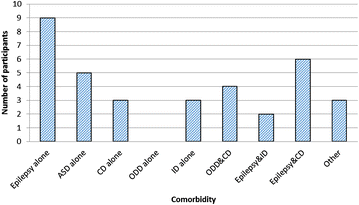Prevalence and associated factors of attention deficit hyperactivity disorder (ADHD) among Ugandan children; a cross-sectional study
- PMID: 28413441
- PMCID: PMC5391555
- DOI: 10.1186/s13034-017-0155-6
Prevalence and associated factors of attention deficit hyperactivity disorder (ADHD) among Ugandan children; a cross-sectional study
Abstract
Background: Attention deficit hyperactivity disorder (ADHD) is a common neuropsychiatric disorder among the children. The burden of ADHD or its associated factors in Uganda are not known. The objective of this study was to determine the prevalence and the associated factors of ADHD among children attending the neurology and psychiatry clinics at Mulago National Referral Hospital.
Methods: Using the disruptive behavior scale (45 items), we investigated the presence of ADHD symptoms among children attending Mulago Hospital. Questionnaires were administered to the primary care-takers of the study participants to gather information on the factors associated with ADHD. All children were subject to a clinical examination. Children presumed to have ADHD, using the aforementioned rating scale were further assessed by a child psychiatrist to confirm the diagnosis and associated co-morbid conditions.
Results: The estimated prevalence of DSM-IV ADHD symptoms was 11%. Children aged less than 10 years were four times likely to have ADHD (OR 4.1, 95% CI 1.7-9.6, p < 0.001). The demographic factors independently associated with ADHD were age less than 10 years, male gender, history of maternal abnormal vaginal discharge during pregnancy, and no formal education or the highest level of education being primary school.
Conclusion: The prevalence of ADHD among children attending the pediatric neurology and psychiatry clinics is high in our settings and is associated with delayed milestones. Early identification and addressing the co-morbid conditions associated with ADHD such as epilepsy, autism spectrum of disorder, conduct disorder, opposition defiant disorder and intellectual disability in our setting is needed.
Keywords: ADHD; Associated factors; DSM IV; Specialized clinic.
Figures
References
Grants and funding
LinkOut - more resources
Full Text Sources
Other Literature Sources


